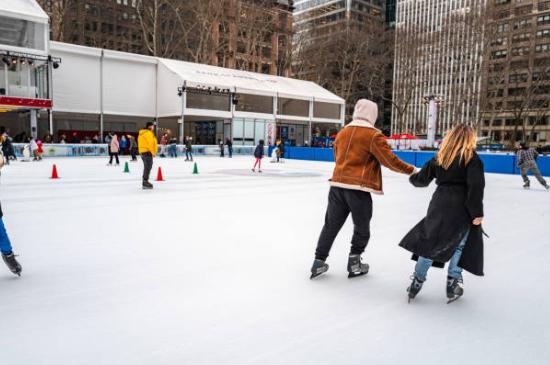Dressing Appropriately for Different Hockey Arena Climates
When you’re planning to attend a hockey game, understanding the arena’s temperature and how to dress appropriately is crucial for your comfort.
Temperature Expectations at Hockey Games
Professional hockey arenas typically maintain temperatures between 60°F (15°C) and 65°F (18°C), making a light jacket or a team jersey suitable for these conditions. In contrast, recreational hockey rinks tend to be cooler, often below 55°F (12°C), requiring more substantial clothing.
Impact of Climate on Arena Temperatures
The climate of the arena’s location significantly affects the indoor temperature. For instance, arenas in colder regions like Edmonton can comfortably maintain the ideal temperature range due to the cold external environment. Conversely, in warmer areas such as Arizona, extensive air conditioning is necessary to prevent the ice from melting, resulting in a colder spectator area.
This was a lesson learned the hard way by my brother-in-law, who had to purchase a blanket at an Arizona game after finding the setting unexpectedly chilly in just a T-shirt and shorts.
Recommended Attire for Hockey Spectators
To ensure comfort at a game, dressing similarly to how you might for a chilly movie theater is advisable. A light jacket or a hockey sweater is generally sufficient for professional games, where the setting resembles an air-conditioned indoor space. However, for those visiting a recreational rink or arenas in colder climates, consider layering up with heavier garments to counteract the lower temperatures.

Essential Guide to Dressing for Recreational Hockey Games
Attending a recreational ice hockey game involves a cooler environment than what you’d find at professional venues. The temperatures at these local arenas typically hover around 55°F (12°C) or lower, necessitating warm attire.
When I visit the arena to cheer on my nephew, I always ensure to wear a warm jacket, gloves, and a ski hat. My sister-in-law, a regular at these games, never forgets to bring a blanket. This is useful either for cushioning the hard, cold seats or for extra warmth over her lap. Given that games can last between one to two hours, and temperatures might dip below 50°F, staying warm is crucial to avoid a drop in your body temperature.
Some arenas offer enclosed viewing areas with temperatures closer to what you’d expect indoors. However, these can feel detached from the energetic ambiance on the ice.
A preferable feature I’ve observed is the installation of overhead heaters in the stands at some venues. These heaters effectively raise the ambient temperature by an additional 5 to 10 degrees, enhancing the comfort and overall experience of spectators.
Thermal Conditions Experienced by NHL Players
During NHL games, players experience unexpectedly high temperatures, contrary to what one might assume given the chilly setting. For instance, during a friendly match at an NHL arena, the intensity of the heat was so pronounced that even minimal extra clothing like a t-shirt became unbearable beneath the hockey gear. This illustrates that the sport’s vigorous nature significantly raises body temperature, rendering additional layers unnecessary.
Impact of Continuous Play on Ice Quality
Maintaining ice quality is a crucial task for ice technicians, especially in professional settings where the heat from the arena can degrade its condition. Over the course of a game, the ice might become less smooth and more problematic for players, affecting their ability to pass the puck accurately and control game flow. This deterioration is often evident through the puck’s erratic movements and the players’ difficulty in handling passes, signaling a decline in the ice’s optimal state.
Warm Beverages at Ice Rinks
Professional arenas offer a variety of food and drink options, including hot beverages like coffee and hot chocolate. Similarly, smaller recreational arenas typically feature concessions that provide these warm drinks and snacks at more budget-friendly prices compared to major league venues.

Understanding Hockey Basics
For newcomers to the sport, gaining an understanding of hockey can start with exploring fundamental aspects like the meanings of the various lines on the ice. A guide like “Hockey 101” can be invaluable for breaking down these basics in an easily digestible way.
Read Also: What is the ROW in hockey?
Conclusion
If you’re gearing up to attend your very first hockey game, whether it’s in a professional or recreational setting, you’re about to experience one of the most exciting sports live. Hockey is renowned for its fast-paced action and the incredible skill level of its players. Prepare to be captivated by the energy and agility on display. Enjoy every moment and the vibrant atmosphere that hockey games are famous for!
FAQ’s: Ice Hockey Arenas Cold
What should I wear to a hockey arena?
If you’re planning to attend a hockey game, it’s wise to wear your team’s jersey to show support. For comfort, layer a long-sleeved top under the jersey to shield against the cold, and opt for cozy sweatpants to stay warm, especially when seated on the often cold metal seating.
Should I dress warm for a hockey game?
Yes, dressing warmly is essential. Wear a puffer coat or a thick jacket for insulation against the cold. It’s important to layer, so include a long-sleeved top or a sweater under your coat. Also, ensure your legs are kept warm with pants or jeans.
How are hockey rinks kept cold?
Hockey rinks use a refrigeration system where a refrigerant cools brine water, which is an anti-freezing agent flowing through steel pipes beneath the ice. These pipes are embedded in a concrete slab maintained at 32°F (0°C), ensuring that water added atop freezes into the solid ice surface used for skating.
Are blankets allowed at hockey games?
Yes, blankets are permitted at hockey games. Since hockey arenas are typically colder, you can bring blankets for added warmth, allowing you to enjoy the game comfortably without needing to wear excessively heavy clothing.



